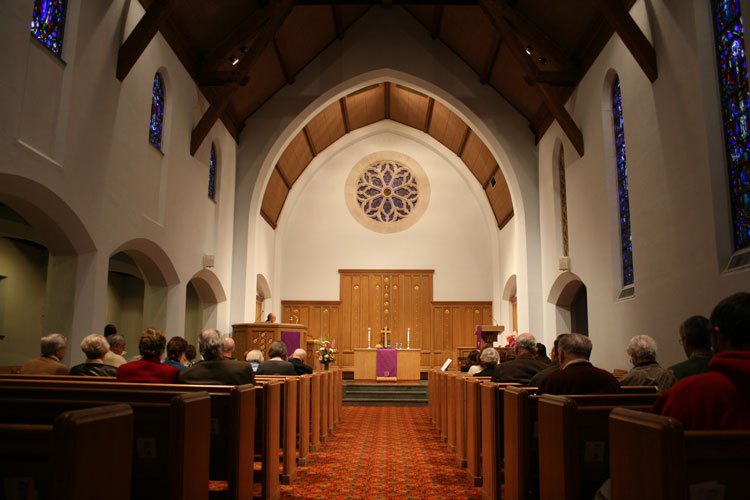
The Westminster Presbyterian Church Memorial Chapel
The stained glass windows in Westminster’s Memorial Chapel were designed and created by Charles J. Connick Associates, Boston, Massachusetts. Below you will find the text of the program used at the 1952 dedication of this beautiful place of Peace lovingly given as a memorial to all the youth of Westminster who have given their lives in service to others.
[metaslider id=394]
Overview of the Chapel Windows
South Chancel Rose
The Parables Window
This window is devoted to the Parables of Our Lord, a theme especially appropriate over the altar, as so many are likened unto the Kingdom of Heaven. A growing and interlacing vine form unites them through the principal petals sur-rounding the central Chi Rho monogram of Christ. It is in white, the color of purity, on a field of ruby, the traditional color of divine love.
Reading clockwise, the upper petal symbolizes Our Lord’s Parable of the Candle under a Bushel, as related by Saint Matthew. The second represents the Parable of the Barren Fig Tree as told by Saint Luke. The third represents the Goodly Pearl in the scales overbalancing great riches. (Matthew 13:44).
Next is the Parable of the Mustard Seed, representing the great herb with the birds of the air lodging in its branches. (Matthew 13:31.) At the bottom is the Hid Treasure, buried in the field beneath flowers. (Matthew 13:44).
Saint Matthew’s Parable of the Tares among the Wheat is symbolized in the next panel followed by the story of the Two Houses-the sturdy one built on a rock, and the other built upon the sand, which was easily destroyed. The last is the Parable of the Leaven permeating the t:lree measures of meal (Matthew 13:33.)
The blue fields of the smaller outer petals, the color of heavenly contemplation, are accented by ruby flames of divine zeal.
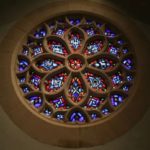
North Entrance Rose
The Beatitudes Window
This rose is designed as a great symbol of color and light of the Beatitudes,- the way of true Christian life which Our Lord taught in His Sermon on the Mount.
At the center is the eight-pointed cross of the Beatitudes, surrounded by their traditional symbols.
At the top, the Dove of the Blessed Poor in Spirit; next, the Inverted Torch of Those that Mourn; the Lamb of the Blessed Meek; the Scales for Those which do Hunger and Thirst for Righteousness.
At the bottom, the Broken Sword of the Merciful; next, the Lily of the Pure in Heart; the Olive Branch of the Peacemakers; and finally, the Heavenly Crown of the Persecuted.
Secondly petals are enriched with flames of divine zeal, and stars of heavenly steadfastness.
The central portion of this window is designed in a warmer palette than the opposite one in the south, extending out into the deep rich blues which predominate in the south window. However, the latter has sufficient notes of lovely ruby to beautifully harmonize the two roses.
Lancet Windows Depicting Actual Westminster Activities
South Lancet – Ministry of Education
The Lamb of God, symbol for Christ.
Christ calling his first disciples, Peter and Andrew, with the boat and water; and the remainder of the twelve grouped in smaller medallions.
Christ delivering the Sermon on the Mount, the basis of the Christian teaching.
A typical teacher with her class in this church; the smaller medal- lions depicting, various means of learning (clockwise- reading, listening, speakingand writing.
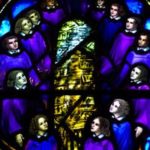
Central Lancet – Pastoral Ministry
The Hand of God surrounded by the nimbus, symbol for the Father.
Moses leading the children of Israel out of exile, guided by pillars of fire and cloud. Smaller medallions depicting (clockwise) water coming from the rock, the Ten Commandments, the serpent and sword, and the parting of the Red Sea.
Isaiah, the greatest of prophets, surrounded by groups of listeners. At his feet, the vision of the seraph bearing the coals of fire.
A preacher in the pulpit of this chapel, surrounded by medallions depicting the pastoral functions (clockwise). “I was sick and ye visited me; thirsty, and ye gave me drink; hungry and ye fed me; in prison, and ye came unto me.”
North Lancet – Ministry of Music
The Descending Dove, symbol for the Holy Spirit.
A medieval organist, accompanied by musical angels, playing under the approbation of the Holy Spirit; smaller medallions depicting ancient instruments mentioned in the 150th Psalm, the harp and cymbals.
King David, the “Sweet Singer of Israel”, with his lute. At his feet, David, the young shepherd, plays for King Saul.
The “Round-the-Table” Car0l service in this church, featuring the Lincoln Westminster Choir. Smaller medallions depicting (clockwise) the Chapel Choir, the Antiphonal Choir, the Boys’ Choir and the Carol Choir.
The Door Lights
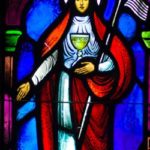
These three windows represent one theme-the Resurrection to Eternal Life. The central panel depicts the Risen Christ with the sleeping guards beneath his feet. The three women who came to the sepulchre at dawn are represented by the east panel; and the disciples, Peter and John, who came to investigate their story, are pictured in the west panel. Traditional symbols of the Resurredion- the eagle rising out of the flames, and the peacock, symbol of eternal life-are also to be seen here.
These family transept windows thus give spiritual significance to the crises of the family-birth, childhood, and death, relating these experienc.es to God and the Christian life.
These windows portray the Biblical passages set-ting forth Christ as the Good Shepherd at the open door (west door panel); and the Church arrayed as a Queen with chalice and banner of victory (east door panel) so often represented In medieval stained glass and stone carvings.
The North Family Transept Windows
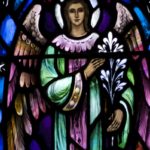
These three windows represent one theme – the Resurrection to Eternal Life.
The central panel depicts the Risen Christ with the sleeping guards beneath his feet. The three women who came to the sepulchre at dawn are represented by the east panel; and the disciples, Peter and John, who came to investigate their story, are pictured in the west panel. Traditional symbols of the Resurredion- the eagle rising out of the flames, and the peacock, symbol of eternal life-are also to be seen here.
These family transept windows thus give spiritual significance to the crises of the family-birth, childhood, and death, relating these experienc.es to God and the Christian life.
The West Family Transept Windows
These two panels depict the Angel of the Annunciation (north panel) and Rapheal, the Guardian Angel of Children (south panel).
The Annunciation panel depicts Mary at the moment when she has learned that she will be the mother of Christ. Following this annunciation she uttered the words of prayer and thanksgiving which we call the Magnificat in Luke’s gospel, as depicted in the lower medallion.
The Raphael panel pictures the apocryphal story of Tobias who during his father’s blindness received the care and ministry of the Guardian Angel Raphael.
The lower medallion pictures the boy’s struggle with the fish from vthich ordeal he was saved by the angel. This story has become a traditional symbol of the love and care of God for His children.
The West Family Transept Windows
These two panels depict the Angel of the Annunciation (north panel) and Rapheal, the Guardian Angel of Children (south panel).
The Annunciation panel depicts Mary at the moment when she has learned that she will be the mother of Christ. Following this annunciation she uttered the words of prayer and thanksgiving which we call the Magnificat in Luke’s gospel, as depicted in the lower medallion.
The Raphael panel pictures the apocryphal story of Tobias who during his father’s blindness received the care and ministry of the Guardian Angel Raphael.
The lower medallion pictures the boy’s struggle with the fish from vthich ordeal he was saved by the angel. This story has become a traditional symbol of the love and care of God for His children.
The East Clerestory Windows
These windows honor the four writers of the gospels (from north to south) Matthew, Mark, Luke and John.
In medieval tradition, all bear pens and the open books of their writings. The dominant colors are counter-changed with Matthew and Luke in ruby cloaks, set in fields of blue, while Mark and John are predominantly blue in fields of ruby.
Above Matthew is his traditional symbol of the winged man (because he begins his gospel with the genealogy of Jesus); below him are the stars of divine steadfastness.
Above Mark is the winged lion (his gospel begins with a voice crying in the wilderness) and below him the white lily of purity.
Above Luke is the winged ox (his gospel begins with Zecharaiah performing the priestly function of sacrifice, customarily the ox) and below him the flames of religious zeal.
Above John is the winged eagle (whose gospel soars to heights sublime in the opening words) and below him the torch of inspiration and enlightenment.